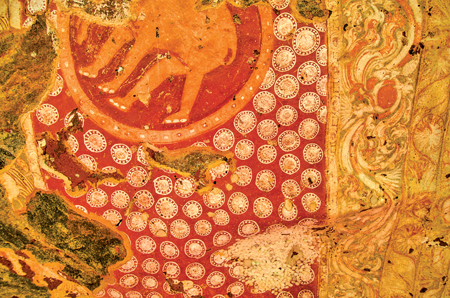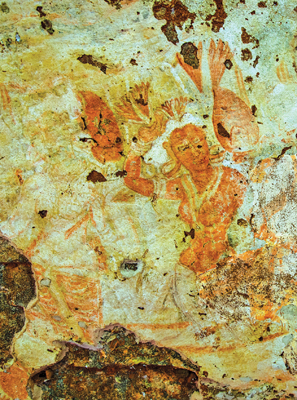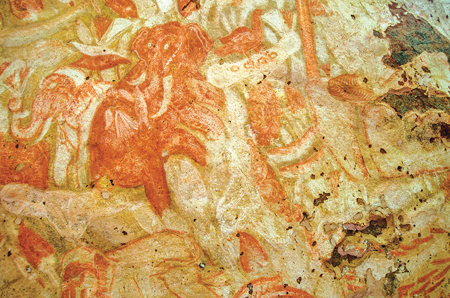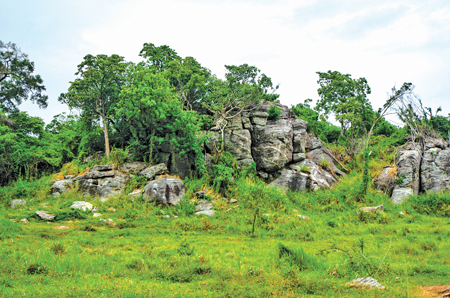 The eerily haunting sounds of peacock juxtaposed with those of the laughing thrush fill the morning air as we follow the 10 kilometre, narrow and near inaccessible jungle track from Kotiyagala to Mailla. The potholes, muddy streams (Aras) and rocky protrusions make the journey arduous, compelling us to make frequent stops and at times literally crawl. But getting to the final destination – the Mailla caves- is worth the hiccups and the bother, although getting there also turned out to be another issue when we got hopelessly almost lost the track.
The eerily haunting sounds of peacock juxtaposed with those of the laughing thrush fill the morning air as we follow the 10 kilometre, narrow and near inaccessible jungle track from Kotiyagala to Mailla. The potholes, muddy streams (Aras) and rocky protrusions make the journey arduous, compelling us to make frequent stops and at times literally crawl. But getting to the final destination – the Mailla caves- is worth the hiccups and the bother, although getting there also turned out to be another issue when we got hopelessly almost lost the track.

Floral designs on the rock ceiling
The trek to the Mailla caves is through a wasteland of chenas. It is a landscape burnt to the ground, a depressing sea of burnt tree trunks tearing at your throat and choking you. The maize chenas are everywhere. Dense forest patches still surround the isolated hill tops.
The tracks were deserted and there is no one to ask directions from. Wandering around, we finally come across a boy from Kotiyagala, returning from his chena, who offers to accompany us to the Mailla caves. Our team to the Mailla caves comprised avid four nature enthusiasts including my son.
The Mailla caves are close to the Lahugala and Yala National Parks, in an area more familiar for wild elephant and bear presence. In 1975, the road to Mailla via Kotiyagala cut across a heavily grown jungle, with a significant wild life population. Over the past few decades, chena cultivation and deforestation has denuded the forest, exposing the caves to the elements and in the process, destroying the priceless artefacts such as paintings and clay statues.
Trek to Mailla

A painting resembling the Sigiriya Apsara on the ceiling of the rock cave of Mailla
The cluster of rocky boulders, which is Mailla proper, now lies in the middle of an isolated pocket of jungle amid a vast stretch of maize cultivation. Access to the caves is by foot and it is a long trek, across a sea of Illuk grass, shrub jungles, rock boulders and mud filled streams. Entrance to the Mailla cave complex is through the main cave.
Upon entry, we come across some drawings on the rock walls. These are believed to have been drawn by the Veddas, and depict a figure riding an elephant. The main entrance leads to a cluster of caves, some of which are said to have been occupied by bhikkhus. We saw some bricks walled dwellings built into the caves on the way to the main Mailla cave.
After a 30 minute trek through the forest canopy, we came to an oval shaped rock cave shrine which contains a reclining Buddha statue made of bricks and clay. Its head, chest and lower section have been hacked by treasure hunters, but parts that are intact indicate it had been a pure white statue once upon a time. On the ceiling of this cave adores fascinating colourful paintings which are on the verge of disappearing.
According to historical records, the cave shrine of Mailla evolved into a Buddhist hermitage and was embellished with all the trapping of a prominent Buddhist shrine between the 4th and 5th Century.
The most extraordinary feature of this forgotten place is the fascinating paintings on the ceiling, unsullied, intact and left alone by man and the elements. The red and yellow painting covering surfaces made of two to three layers clay plaster mixer with paddy seeds are considered to be some of the oldest paintings in the country.
Bejewelled maidens

One of the paintings on the ceiling, belonging to the 5th Century
Among the paintings are exquisite floral designs, similar to what’s found among Sigiriya paintings. There are also figures of beautiful, bear breasted, bejewelled maidens with flowers in their hands and hair, not unlike the Apsaras of Sigiriya, painted on the ceiling.
The maidens are painted mostly in red and provide a stark contrast to the white background. But providing exquisite companionship to the fair beauties are elephants, birds, oxen, spotted deer, jungle fowls and geese, painted in a style that renders them vivid and near real.
We discover that a place of prominence has been given to the images of elephants in the Mailla caves. Prominent are the paintings of several elephants – one engaged in water sports, another carrying a lotus in its trunk and the third on the verge of escaping from the scene. The scenes in the Mailla caves resemble the rock carvings of the Ran Masu Uyana at the Isurumuniya temple in Anuradhapura.
Reclining Buddha statue

The wooded road to the Mailla caves
The massive statue of the reclining Buddha in the main cave was built during the 8th Century. A stupa had also been built atop the rock boulder at some point. Like the Mailla Buddha statue, the stupa on the overhead on the crest of the rock boulder has been destroyed by treasure hunters, and all that remains today is a flat heap of rubble with weeds and ferns growing in places once enshrined with relics.
Despite the destruction, the Mailla Buddha statue is in better condition today due to a Good Samaritan, who had taken it upon himself to repair and retouch the vandalised statue.
In the back of the main cave shrine is accommodated to another small shrine where a seated Buddha statue had been built. Now, everything is in ruins; only some bricks were strewn on the ground indicating that in the past this had been a reputed Buddhist shrine.
The Mailla caves are probably one of the ancient art repositories in the country, offering a glimpse of aesthetic creativity of a generation of a bygone era. It is every one’s duty to protect this priceless treasure to the posterity.









